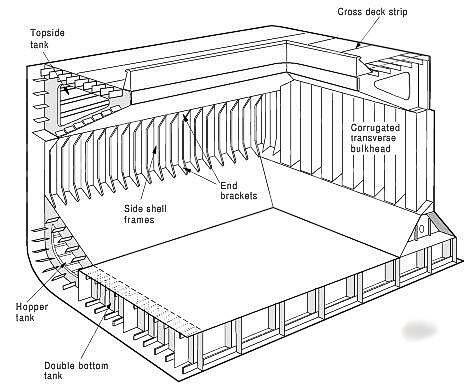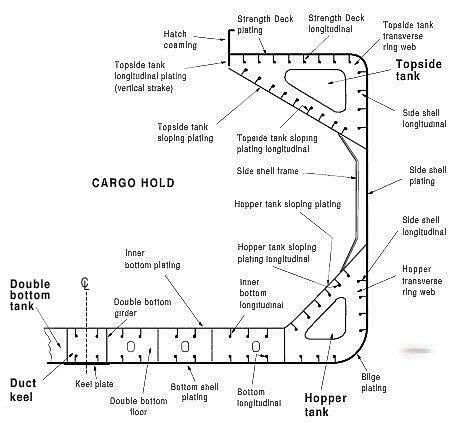

Home ||| Bulk Cargo ||| Planning ||| Care ||| Safety||| Self unloaders
Structural integrity & design limitations of modern seagoing bulk carriers
 Most seafaring nations have established classification societies which review standards for the construction of cargo vessels. Classification societies publish construction guidelines and stability and operating standards to ensure vessel safety and standardization of ship construction and other marine equipment.
Most seafaring nations have established classification societies which review standards for the construction of cargo vessels. Classification societies publish construction guidelines and stability and operating standards to ensure vessel safety and standardization of ship construction and other marine equipment.
To carry the maximum amount of cargo, bulk carriers are designed with a high block coefficient (Cb), ie their hulls are given a full form.
While any basic bulk carrier can be suitable for carriage of cargoes such as grain, coal or sugar, it does not necessarily mean it can also carry heavy density cargoes such as iron ore. Heavy density cargoes are carried in specially designed bulk carriers that are additionally strengthened or specialised ore carriers. Their class notations are based on their design compliance with the Classification requirements.
Cargo Gear
Bulk carriers up to handymax size may have their own cargo gear located between cargo holds. These ships are referred to as `geared bulkers'. For example, a 48,000 dwt bulk carrier could have 4 cranes for loading/discharging cargoes. These ships may also carry their own grabs for use in ports. The advantage of shipboard cargo gear is a quick turnaround in port, increasing the shipowner's profit margins.
The position and type of crane will vary from ship- to-ship. However, larger bulk carriers do not carry any cargo gear and have to rely on shore based equipment such as conveyor belts, shoots or cranes. The shipowner does not have to worry about the initial cost of the gear or its maintenance and, at the same time, the carriage capacity of the ship increases by an amount equivalent to the weight of the cargo gear.
Fuel consumption
While a faster speed may allow a ship to complete more voyages, it may not be economically efficient since fuel costs increase exponentially with speed. Therefore, the average maximum speed of bulk carriers varies between 10.514.5 knots.
All ships are designed with limitations imposed upon their operability to ensure that the structural integrity is maintained according to classification society guideline. Therefore, exceeding these limitations may result in over-stressing of the ship's structure which may lead to catastrophic failure. The ship's approved loading manual provides a description of the operational loading conditions upon which the design of the hull structure has been based.
The loading instrument or vessels approved loading software provides a means to readily calculate the still water shear forces and bending moments, in any load or ballast condition, and assess these values against the design limits.
A ship's structure is designed to withstand the static and dynamic loads likely to be experienced by the ship throughout its service life.

Fig : Cargo hold construction of a typical bulk carrier
The loads acting on the hull structure when a ship is floating in still (calm) water are static loads. These loads are imposed by the:
i) Actual weight of the ship's structure, outfitting, equipment and machinery.
ii) Cargo load (weight).
iii) Bunker and other consumable loads (weight).
iv) Ballast load (weight).
v) Hydrostatic pressure (sea water pressure acting on the hull).
Dynamic loads are those additional loads exerted on the ship's hull structure through the action of the waves and the effects of the resultant ship motions (i.e. acceleration forces, slamming and sloshing loads). Sloshing loads may be induced on the ship's internal structure through the movement of the fluids in tanks/holds whilst slamming of the bottom shell structure forward may occur due to emergence of the fore end of the ship from the sea in heavy weather.
Cargo over-loading in individual hold spaces will increase the static stress levels in the ship's structure and reduce the strength capability of the structure to sustain the dynamic loads exerted in adverse sea conditions.
Special care needs to be taken with heavy cargoes such as iron ore, scrap iron, lead and other concentrates. On general bulk carriers with uniform hold lengths alternate hold loading or block hold loading may be utilized to stow high density cargoes. With such loading arrangements high shear forces occur at the ends of the holds requiring additional strengthening of the side shell in way of the bulkheads.
Defining a bulk carrier structural configuration
A typical bulk carrier is a single deck ship with a double bottom, hopper tanks, single skin transverse framed side shell, topside tanks and deck hatchways.

Fig : Transverse section of a typical bulk carrier
Bulk carrier design does not alter significantly with size; fundamentally, a bulk carrier of 35000 tonnes deadweight usually has the same structural configuration as that of a ship of 70000 tonnes deadweight.To carry the maximum amount of cargo, bulk carriers are designed with a high block coefficient (Cb), ie their hulls are given a full form.
Structural items such as the side shell, bottom shell, strength deck, transverse bulkheads, inner bottom and topside and hopper tank sloping plating provides local boundaries of the structure and carries static and dynamic pressure loads exerted by, for example, the cargo, bunkers, ballast and the sea. This plating is supported by secondary stiffening members such as frames or longitudinals. These secondary members transfer the loads to primary structural members such as the double bottom floors and girders or the transverse web frames in topside and hopper tanks, etc.
The transverse bulkhead structures, including its upper and lower stools, together with the cross deck and the double bottom structures are the main structural members which provide the transverse strength of the ship to prevent the hull section from distorting. In addition, if ingress of water into any one hold has occurred, the transverse watertight bulkheads prevent progressive flooding of other holds.
Classification Society Establishes Design Standards For Bulk Carriers
With regard to the number of recent bulk carrier losses attributed to the liquefaction of nickel ore cargoes, a classification society says it has established strict design standards for the modification, or new-buildings, of these ship-types that would enable them to carry fine ores safely at any given moisture content.
Under the IMSBC Code, Group A cargoes are those that may liquefy if shipped at moisture content in excess of their Transportable Moisture Limit (TML). The Society's new notation will be assigned to ships specially constructed or fitted to carry Group A cargoes with a moisture content in excess of their TML. The new notation - IMSBC-A, applies to a number of cargoes that may liquefy, for which a full list is available. The Head of the classification society's Technical Department said that mandatory application of the IMSBC Code enhances the safety of bulk carriers through the setting of constructional and operative requirements.
However, details of how to safely execute a voyage with unprocessed ores that may liquefy en route, are not specified. The rules require vessels to load ores if the TML is not exceeded but establishing that is difficult, as the TML is prone to liquefaction by recent rain or other factors. He said it was therefore much safer to design or convert an existing ship to withstand cargo liquefaction, adding that under the new standards ships would not have to rely on (unreliable) moisture tests at load ports.
Related articles
- Design of ships longitudinal subdivisions & of transverse watertight bulkheads
- Bulk carrier
General arrangement
- Definitions of available Bulk carrier sizes
- Tank construction & required strength for ships carrying bulk cargo
- Handling water ingress problems in bulk carrier, investigation and countermeasures
- Survival and safety procedure for bulk carriers
- Hatch cover strength requirement for a seagoing bulk carrier
Our detail pages illustrated many safety aspects of Bulk carrier
Home page |||Bulk carrier types ||| Handling of bulk coal |||Cargo planning ||| Carriage of grain |||Risk of iron ores |||Self unloading bulk carriers |||Care of cargo & vessel |||Cargoes that may liquefy |||Suitability of ships |||Terminal guideline |||Hold cleaning |||Cargo cranes |||Ballast handling procedure |||Bulk carrier safety |||Fire fighting systems |||Bulk carrier General arrangement

Operation of sea going bulk carriers involved numerous hazards . Careful planning and exercising due caution for all critical shipboard matters are important . This site is a quick reference to international shipping community with guidance and information on the loading and discharging of modern bulk carriers so as to remain within the limitations as specified by the classification society.
It is vital to reduce the likelihood of over-stressing the ship's structure and also complying with all essential safety measures for a safe passage at sea. Our detail pages contain various bulk carrier related topics that might be useful for people working on board and those who working ashore in the terminal. For any remarks please Contact us
Copyright © 2010 bulkcarrierguide.com All rights reserved.
Although every effort have been taken to improve the accuracy of content provided the publisher of this website cannot gaurantee for errors. Disclaimer Privacy policy Home page
